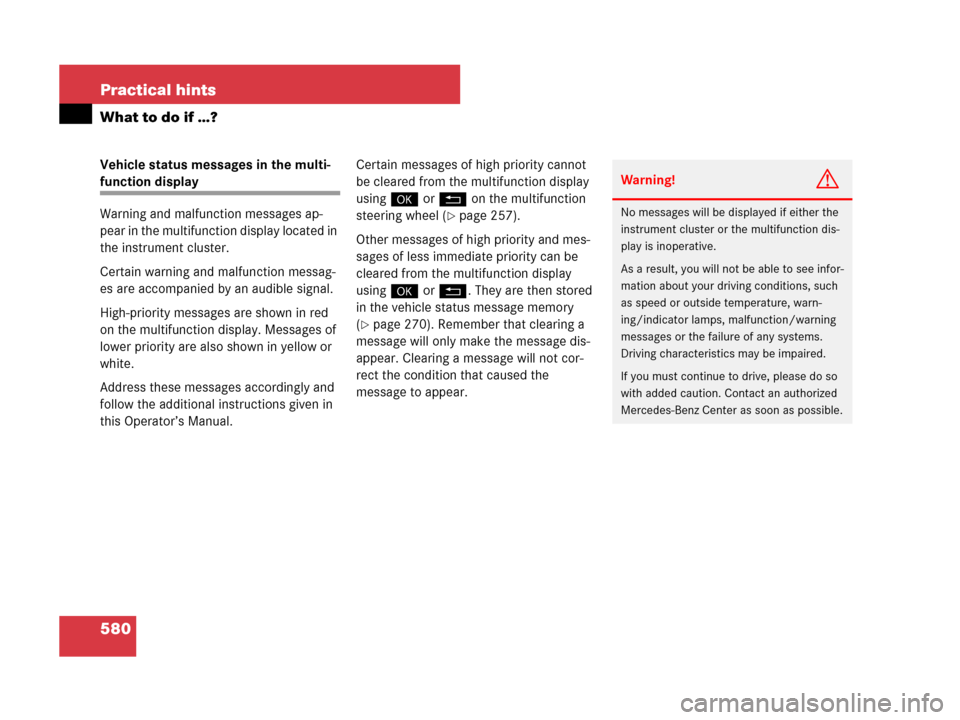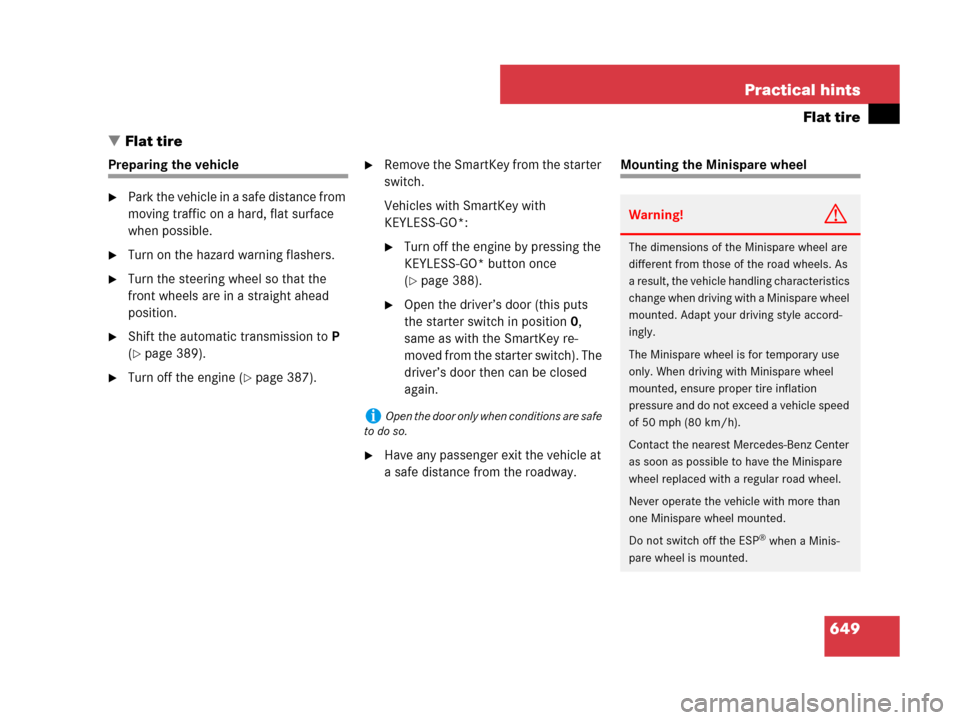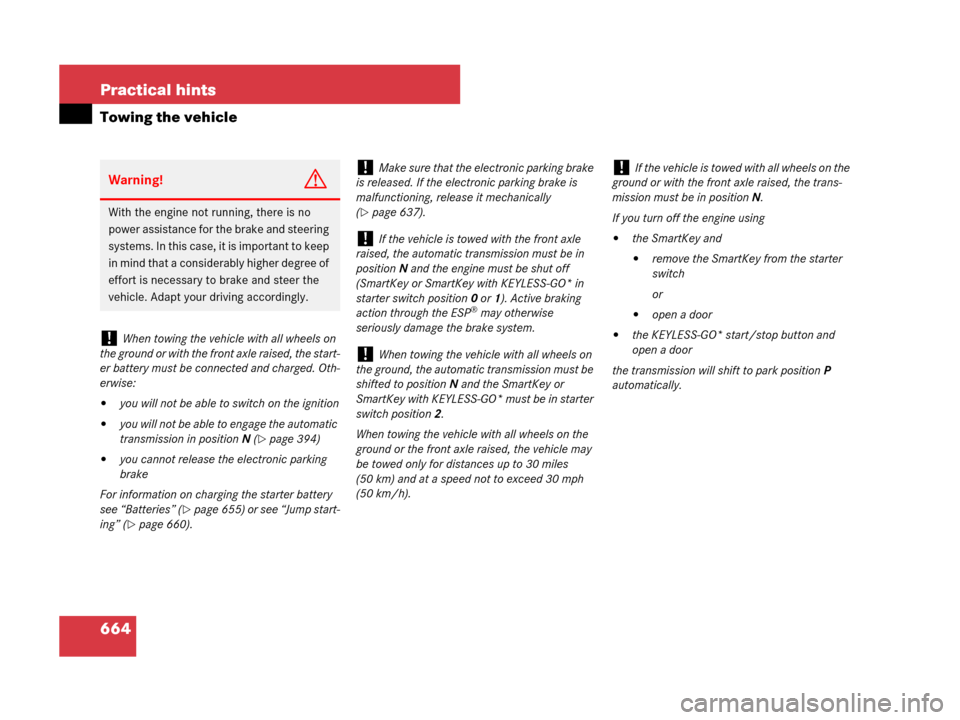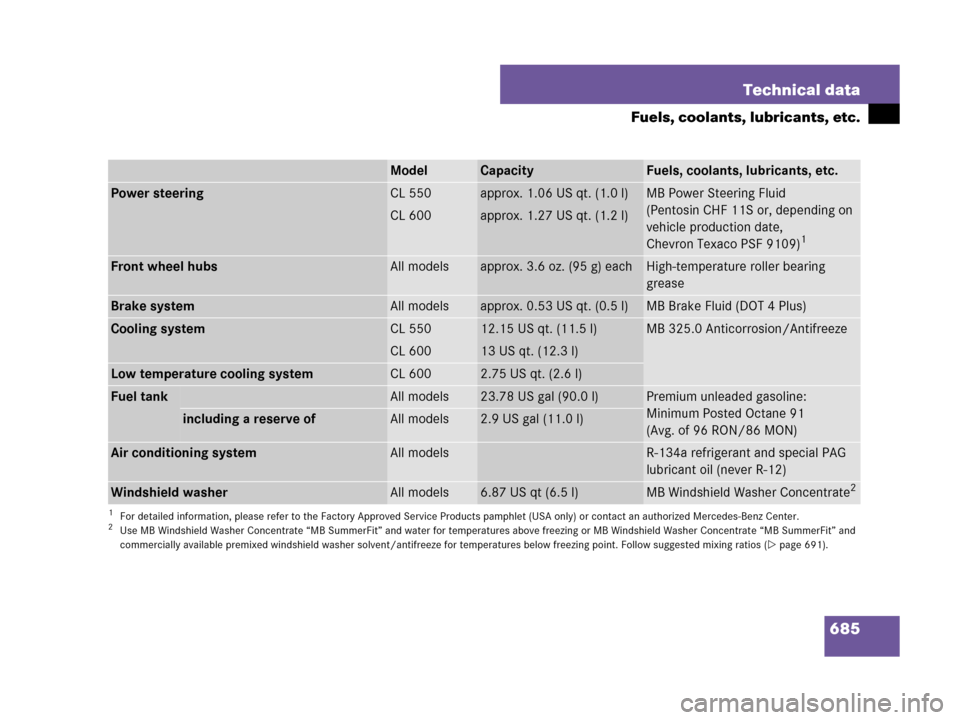Page 583 of 723

580 Practical hints
What to do if …?
Vehicle status messages in the multi-
function display
Warning and malfunction messages ap-
pear in the multifunction display located in
the instrument cluster.
Certain warning and malfunction messag-
es are accompanied by an audible signal.
High-priority messages are shown in red
on the multifunction display. Messages of
lower priority are also shown in yellow or
white.
Address these messages accordingly and
follow the additional instructions given in
this Operator’s Manual.Certain messages of high priority cannot
be cleared from the multifunction display
using# or L on the multifunction
steering wheel (
�page 257).
Other messages of high priority and mes-
sages of less immediate priority can be
cleared from the multifunction display
using# or L. They are then stored
in the vehicle status message memory
(
�page 270). Remember that clearing a
message will only make the message dis-
appear. Clearing a message will not cor-
rect the condition that caused the
message to appear.
Warning!G
No messages will be displayed if either the
instrument cluster or the multifunction dis-
play is inoperative.
As a result, you will not be able to see infor-
mation about your driving conditions, such
as speed or outside temperature, warn-
ing/indicator lamps, malfunction/warning
messages or the failure of any systems.
Driving characteristics may be impaired.
If you must continue to drive, please do so
with added caution. Contact an authorized
Mercedes-Benz Center as soon as possible.
Page 596 of 723
593 Practical hints
What to do if …?
Symbol messages
Display Possible cause/consequencePossible solution
Malfunction
Stop Vehicle!You have started driving although the vehi-
cle level is still too low.
The vehicle is raised. The ABC message
goes out after a few seconds.�Stop your vehicle as soon as it is safe to do
so.
�Wait until the message disappears from the
multifunction display.
You may then drive off.
The vehicle is losing oil.
The ABC message is continuously shown.�Stop your vehicle as soon as it is safe to do
so.
�Call Roadside Assistance.
�Notify an authorized Mercedes-Benz Center.
ABC is malfunctioning.
The ABC message is continuously shown.�Do not turn steering wheel too far to avoid
damaging the front fenders.
�Listen for scraping noises.
�Do not exceed a speed of 50 mph (80 km/h).
�Contact an authorized Mercedes-Benz Cen-
ter as soon as possible.
Page 631 of 723
628 Practical hints
What to do if …?
Display Possible cause/consequencePossible solution
Tele Aid
inoperativeOne or more main functions of the Tele Aid
system are malfunctioning.�Have the Tele Aid system checked by an
authorized Mercedes-Benz Center.
Tire pressure
Caution, tire defectAdvanced TPMS:
One or more tires are deflating.�Carefully bring the vehicle to a halt, avoiding
abrupt steering and braking maneuvers.
�If necessary, change the wheel (�page 649).
Caution
Tire defectAdvanced TPMS:
One or more tires are deflating. The respec-
tive tire is shown in the multifunction
display.�Carefully bring the vehicle to a halt, avoiding
abrupt steering and braking maneuvers.
�If necessary, change the wheel (�page 649).
Warning!G
Do not drive with a flat tire. A flat tire affects
the ability to steer or brake the vehicle. You
may lose control of the vehicle. Continued
driving with a flat tire will cause excessive
heat build-up and possibly a fire.
Page 632 of 723
629 Practical hints
What to do if …?
Display Possible cause/consequencePossible solution
Tire pressure
Check tiresAdvanced TPMS:
The pressure is too low in one or more tires.�Carefully bring the vehicle to a halt, avoiding
abrupt steering and braking maneuvers.
�Check and adjust tire inflation pressure as
required (
�page 534).
�If necessary, change the wheel (�page 534).
Check tiresAdvanced TPMS:
The pressure is too low in one or more tires.
The respective tire is shown in the multi-
function display.�Carefully bring the vehicle to a halt, avoiding
abrupt steering and braking maneuvers.
�Check and adjust tire inflation pressure as
required (
�page 534).
�If necessary, change the wheel (�page 534).
Warning!G
Do not drive with a flat tire. A flat tire affects
the ability to steer or brake the vehicle. You
may lose control of the vehicle. Continued
driving with a flat tire will cause excessive
heat build-up and possibly a fire.
Page 652 of 723

649 Practical hints
Flat tire
�Flat tire
Preparing the vehicle
�Park the vehicle in a safe distance from
moving traffic on a hard, flat surface
when possible.
�Turn on the hazard warning flashers.
�Turn the steering wheel so that the
front wheels are in a straight ahead
position.
�Shift the automatic transmission toP
(
�page 389).
�Turn off the engine (�page 387).
�Remove the SmartKey from the starter
switch.
Vehicles with SmartKey with
KEYLESS-GO*:
�Turn off the engine by pressing the
KEYLESS-GO* button once
(
�page 388).
�Open the driver’s door (this puts
the starter switch in position0,
same as with the SmartKey re-
moved from the starter switch). The
driver’s door then can be closed
again.
�Have any passenger exit the vehicle at
a safe distance from the roadway.
Mounting the Minispare wheel
iOpen the door only when conditions are safe
to do so.
Warning!G
The dimensions of the Minispare wheel are
different from those of the road wheels. As
a result, the vehicle handling characteristics
change when driving with a Minispare wheel
mounted. Adapt your driving style accord-
ingly.
The Minispare wheel is for temporary use
only. When driving with Minispare wheel
mounted, ensure proper tire inflation
pressure and do not exceed a vehicle speed
of 50 mph (80 km/h).
Contact the nearest Mercedes-Benz Center
as soon as possible to have the Minispare
wheel replaced with a regular road wheel.
Never operate the vehicle with more than
one Minispare wheel mounted.
Do not switch off the ESP
® when a Minis-
pare wheel is mounted.
Page 667 of 723

664 Practical hints
Towing the vehicle
Warning!G
With the engine not running, there is no
power assistance for the brake and steering
systems. In this case, it is important to keep
in mind that a considerably higher degree of
effort is necessary to brake and steer the
vehicle. Adapt your driving accordingly.
!When towing the vehicle with all wheels on
the ground or with the front axle raised, the start-
er battery must be connected and charged. Oth-
erwise:
�you will not be able to switch on the ignition
�you will not be able to engage the automatic
transmission in positionN (
�page 394)
�you cannot release the electronic parking
brake
For information on charging the starter battery
see “Batteries” (
�page 655) or see “Jump start-
ing” (
�page 660).
!Make sure that the electronic parking brake
is released. If the electronic parking brake is
malfunctioning, release it mechanically
(
�page 637).
!If the vehicle is towed with the front axle
raised, the automatic transmission must be in
positionN and the engine must be shut off
(SmartKey or SmartKey with KEYLESS-GO* in
starter switch position0 or1). Active braking
action through the ESP
® may otherwise
seriously damage the brake system.
!When towing the vehicle with all wheels on
the ground, the automatic transmission must be
shifted to positionN and the SmartKey or
SmartKey with KEYLESS-GO* must be in starter
switch position2.
When towing the vehicle with all wheels on the
ground or the front axle raised, the vehicle may
be towed only for distances up to 30 miles
(50 km) and at a speed not to exceed 30 mph
(50 km/h).
!If the vehicle is towed with all wheels on the
ground or with the front axle raised, the trans-
mission must be in positionN.
If you turn off the engine using
�the SmartKey and
�remove the SmartKey from the starter
switch
or
�open a door
�the KEYLESS-GO* start/stop button and
open a door
the transmission will shift to park position P
automatically.
Page 688 of 723

685 Technical data
Fuels, coolants, lubricants, etc.
ModelCapacityFuels, coolants, lubricants, etc.
Power steeringCL 550approx. 1.06 US qt. (1.0 l)MB Power Steering Fluid
(Pentosin CHF 11S or, depending on
vehicle production date,
Chevron Texaco PSF 9109)
1
1For detailed information, please refer to the Factory Approved Service Products pamphlet (USA only) or contact an authorized Mercedes-Benz Center.
CL 600approx. 1.27 US qt. (1.2 l)
Front wheel hubsAll modelsapprox. 3.6 oz. (95 g) eachHigh-temperature roller bearing
grease
Brake systemAll modelsapprox. 0.53 US qt. (0.5 l)MB Brake Fluid (DOT 4 Plus)
Cooling systemCL 55012.15 US qt. (11.5 l)MB 325.0 Anticorrosion/Antifreeze
CL 60013 US qt. (12.3 l)
Low temperature cooling systemCL 6002.75 US qt. (2.6 l)
Fuel tankAll models23.78 US gal (90.0 l)Premium unleaded gasoline:
Minimum Posted Octane 91
(Avg. of 96 RON/86 MON)
including a reserve ofAll models 2.9 US gal (11.0 l)
Air conditioning systemAll modelsR-134a refrigerant and special PAG
lubricant oil (never R-12)
Windshield washerAll models6.87 US qt (6.5 l)MB Windshield Washer Concentrate2
2Use MB Windshield Washer Concentrate “MB SummerFit” and water for temperatures above freezing or MB Windshield Washer Concentrate “MB SummerFit” and
commercially available premixed windshield washer solvent/antifreeze for temperatures below freezing point. Follow suggested mixing ratios (�page 691).
Page 697 of 723

694 Index
Audio (COMAND) 107
CD mode 115
DVD mode 115
MP3 mode 115
Audio (Control system
instrument cluster) 263
CD changer 264
DVD changer 264
Audio DVD
Fast forward/rewind (COMAND) 117
Menu overview (COMAND) 114
Pause function (COMAND) 116
Stop function (COMAND) 116
Auto-dimming, Rear view mirrors 355Automatic climate control 453
Adjusting air distribution
(COMAND) 246
Adjusting air flow from air vents
(COMAND) 249
Adjusting air volume
(COMAND) 246
Adjusting the footwell temperature
(COMAND) 249
Air recirculation mode 458
Central climate control menu
(COMAND) 247
Defrosting 456
Operating via COMAND 244
Rear window defroster 457
Selecting Mono mode
(COMAND) 248
Setting temperature
(COMAND) 245
Setting the temperature 456
Switching cooling on or off
(COMAND) 247Automatic headlamp mode 271, 364
Automatic lighting control,
Interior lighting 370
Automatic locking when driving 334
Automatic shift program 399
Automatic transmission
Accelerator position 396
Automatic shift program 399
Emergency operation
(limp-home mode) 401
Fluid 684
Fluid level 517
Gear ranges 398
Gear selector lever 389
Gear shifting malfunctions 401
Hill start assist system 397
Kickdown 396
Program mode selector switch 399
Shifting procedure 392
Starting the engine 378
Steering wheel gearshift control 400
Transmission fluid 517
Transmission positions 393